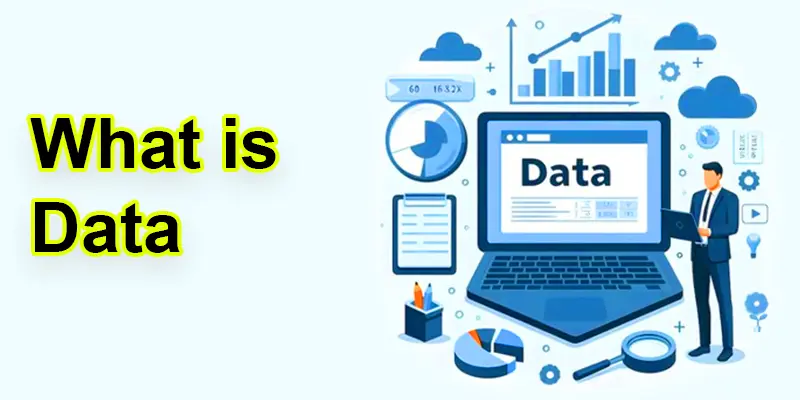Data What Is – Types, Uses, and More
Published: 7 Sep 2024
What is data?
Data is information collected in many forms, like numbers, words, or images, that help us understand the world around us. It can come from things like surveys, websites, or machines and is often used to make decisions or solve problems. When we gather data, we can study it to find patterns, trends, and useful insights that help us improve processes or make better choices.
Why data is important?
- Helps in decision-making: Data provides clear information, allowing people and businesses to make smart choices.
- Shows patterns and trends: By studying data, we can find trends that help predict what might happen in the future.
- Improves efficiency: Data helps identify areas where things can be done faster or better.
- Supports innovation: New ideas and solutions are often discovered by analyzing data.
- Solves problems: Data helps us understand problems and find the best solutions based on facts, not guesses.

How is data stored?
Data can be stored in various forms, such as on computer hard drives, USB drives, and memory cards. It can also be saved as physical documents or files. This variety of storage options helps keep data accessible and organized.
- On Computers: Data is saved on computer hard drives or solid-state drives, where it can be quickly accessed.
- In the Cloud: Data is stored on remote servers over the internet, allowing access from anywhere.
- On External Devices: Data can be kept on USB drives, external hard drives, or memory cards for easy transport.
- In Databases: Data is organized and stored in structured databases, making it easy to retrieve and manage.
- In Physical Forms: Data can also be stored in printed documents or files, though this is less common in the digital age.
Types of Data
- Text Data: Text data consists of words, sentences, and paragraphs that convey information. It includes anything from emails and reports to social media posts and articles. This type of data is used to share ideas, communicate, and store written content in a format that’s easy to read and understand.
- Numerical Data: Numerical data consists of numbers and figures used to represent and analyze information. It includes things like sales amounts, test scores, or measurements. This type of data helps with calculations, comparisons, and making decisions based on quantifiable facts.
- Categorical Data: Categorical data represents information by grouping it into categories or labels. Examples include types of products, colors, or age groups. This type of data helps organize and sort information into distinct categories, making it easier to analyze and understand patterns.
- Date and Time Data: Date and time data records when events occur or deadlines are due. It includes information like specific dates, times, and durations. This type of data helps track schedules, manage appointments, and understand timelines by providing a clear sense of when things happen.
- Multimedia Data: Multimedia data includes different types of media like images, videos, and audio files. It provides visual and sound information, making it useful for creating rich content such as presentations, movies, or music. This type of data helps convey messages in a more engaging and interactive way.

What is Information?
Information is data that has been arranged or interpreted to be useful and meaningful. It helps us understand something better and make informed decisions.
For example, if you collect numbers about sales and then analyze them to understand trends, that analysis becomes information. It helps us make sense of data and use it to make decisions or learn more about something.
Data Management: what is it?
The process of arranging, handling, and storing data to make it accurate, safe, and accessible is known as data management. It involves tasks like saving data, updating it, and making sure it’s available when needed, helping people and businesses use their data effectively.
Uses of Data Management
- Keeps Data Organized: Helps keep data in order so it’s easy to find and use.
- Improves Accuracy: Ensures the data is correct and up-to-date, reducing mistakes.
- Protects Data: Keeps data safe from loss or theft with proper security measures.
- Supports Decision-Making: Provides reliable information that helps make informed choices.
- Increases Efficiency: Streamlines data handling, making it faster and easier to work with.
What are data professionals?
Data professionals are people who work with data to help organizations make better decisions. They collect, analyze, and manage data to find useful insights and ensure that the data is accurate and secure. Their job involves working with various tools and techniques to turn data into valuable information for businesses and other organizations.
Uses of Data
- Making Decisions: Making decisions with data means using information to choose the best option. For example, businesses look at sales data to decide what products to stock up on. By analyzing data, people can see trends and patterns that help them make smarter, more informed choices.
- Understanding Trends: Understanding trends means looking at data to see patterns and changes over time. For example, by examining sales numbers, a company can identify which products are becoming more popular. Recognizing these trends helps businesses adapt and plan for the future based on what’s happening now.
- Improving Services: Improving services involves using data to find out what customers like and dislike. For example, by analyzing feedback, a company can see which features are popular and which ones need fixing. This helps them make changes that enhance their products or services, leading to happier customers.
- Solving Problems: Solving problems with data means using information to identify what’s wrong and figure out how to fix it. For example, if a business notices a drop in sales, it can analyze the data to find out why it’s happening and what changes might help improve the situation. This approach helps in finding practical solutions based on facts.
- Predicting Future Outcomes: Predicting future outcomes involves using past data to guess what might happen next. For example, by looking at previous sales trends, a business can estimate future sales and plan accordingly. This helps in making informed decisions about what to expect and how to prepare for it.
Become a Data Science & Business Analytics Professional:
1. Focus:
- Data Science: Focuses on creating models and algorithms to analyze complex data and make predictions.
- Business Analytics: Focuses on interpreting data to make decisions and improve business processes.
2. Skills:
- Data Science: Requires skills in programming, machine learning, and statistical analysis.
- Business Analytics: Requires skills in data visualization, reporting, and understanding business needs.
3. Tools:
- Data Science: Uses tools like Python, R, and machine learning platforms.
- Business Analytics: Uses tools like Excel, SQL, and business intelligence software.
4. Objective:
- Data Science: Aims to develop new insights and predictive models from data.
- Business Analytics: Aims to use data to improve business strategies and operations.
5. Approach:
- Data Science: Often involves building complex models and experimenting with data.
- Business Analytics: Focuses on analyzing historical data to support decision-making and strategic planning.
Top 5 Jobs in Data
- Data Scientist: A data scientist analyzes complex data using algorithms and models to find patterns and make predictions. They help companies understand trends and make decisions based on data insights.
- Data Analyst: A data analyst looks at data to find useful information and create reports. They help businesses understand what the data shows and suggest ways to improve operations.
- Business Intelligence (BI) Analyst: A BI analyst focuses on using data to support business decisions. They create dashboards and reports to show trends and performance metrics, helping companies make strategic choices.
- Data Engineer: A data engineer builds and maintains the systems and infrastructure needed to store and process large amounts of data. They ensure that data is available and organized for analysis.
- Data Architect: A data architect designs and organizes data systems to ensure they are efficient. They plan how data is stored, accessed, and managed to support business needs.
What is the cycle of data processing?
The Data Processing Cycle is a set of procedures for managing and using data efficiently.
- Data Collection: The practice of obtaining information from various sources is known as data collection. Surveys, interviews, sensors, and already-existing records can all be used for this. Accurate and pertinent data collection is the aim in order to support analysis and decision-making.
- Data Input: Data input is the step where collected information is entered into a computer system or software. This could involve typing data into a form, uploading files, or feeding data from other sources. Ensuring that the data is accessible and prepared for analysis is the aim.
- Data Processing: Data processing is the stage where collected data is organized and analyzed to make it useful. This involves converting raw data into a format that can be understood, such as creating charts, summaries, or reports. The goal is to extract meaningful insights and information from the data.
- Data Storage: Data storage is the process of saving information in a secure and organized way so it can be accessed later. This can be done using computers, cloud services, or physical storage devices. Proper storage ensures that data is preserved and easily retrievable when needed.
- Data Output: Data output is when you present the results from analyzed data. This can be in the form of reports, charts, or visualizations that show what the data reveals. The goal is to make the information clear and useful for making decisions or sharing with others.
- Data Review: Data review is the process of checking the results from data analysis. It involves looking over the reports, charts, or findings to ensure they are accurate and useful. This step helps in making informed decisions based on the data and identifying any areas that might need further investigation or adjustment.
How do we analyze data?
Analyzing data involves examining and interpreting information to find useful patterns and insights.
- Organize Data: Organizing data means arranging it in a clear and structured way so it’s easy to understand. This could involve sorting information into tables, creating lists, or grouping similar items together. Proper organization helps to make the data easier to analyze and use for finding insights.
- Look for Patterns: Looking for patterns means examining the data to spot trends or regularities. For example, you might notice that sales increase every holiday season or that certain products are popular with specific age groups. Identifying these patterns helps you understand how data behaves and make better decisions based on those insights.
- Using Tools: Using tools means applying software or programs to help analyze data more effectively. These tools can create charts and graphs or perform calculations to make the data easier to understand. They help simplify complex information and reveal important insights that might be hard by looking at raw data.
- Draw Conclusions: Drawing conclusions means making decisions or forming opinions based on the data you’ve analyzed. After looking at patterns and using tools, you interpret what the data is telling you. This helps you understand the results and decide what actions to take or what changes might be needed.
Data Longevity & Data Accessibility
- Data Longevity: Data Longevity refers to how long data remains usable and relevant over time. It involves ensuring that data is stored so that it doesn’t become outdated or lost and can be accessed and understood even as technology changes.
- Data Accessibility: Data Accessibility means making sure that data can be easily reached and used by those who need it. In order to provide quick and easy data retrieval for analysis, reporting, or decision-making, data must be organized and stored.

Conclusion – Data and data
Data is a valuable resource that helps us understand the world, make decisions, and solve problems. By collecting, organizing, and analyzing data, we can gain useful insights that improve businesses, services, and everyday life. Managing data well ensures that it remains accurate, secure, and accessible for future use, making it an essential tool in today’s information-driven world.
FAQS – Data to data
What is the meaning of data?
Data refers to facts, figures, or information collected from different sources, which can be used for analysis or decision-making. It can be numbers, words, or even images.
What is data in the context of data mining?
In data mining, data is the raw information that is analyzed to discover patterns or useful insights. It’s like looking through a lot of data to find hidden gems of knowledge.
What is a data type?
A data type refers to the kind of data being used, like numbers, text, or dates. It helps computers understand how to process and store that data.
What is data in relation to data structures?
In data structures, data refers to the individual pieces of information that are stored and organized in a way that makes it easier to use, like in a list or a table.
A data structure: what is it?
Like an array, stack, or tree, a data structure is a method of efficiently arranging and storing data for later use.
What does database mean?
A database is a collection of organized data stored in a computer, where the data can be easily accessed, managed, and updated.
What is data science?
Data science is the field that uses tools, techniques, and algorithms to analyze large sets of data and extract useful information or insights.

- Be Respectful
- Stay Relevant
- Stay Positive
- True Feedback
- Encourage Discussion
- Avoid Spamming
- No Fake News
- Don't Copy-Paste
- No Personal Attacks



- Be Respectful
- Stay Relevant
- Stay Positive
- True Feedback
- Encourage Discussion
- Avoid Spamming
- No Fake News
- Don't Copy-Paste
- No Personal Attacks





